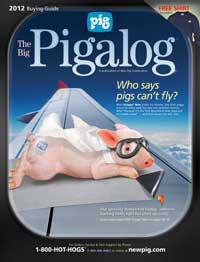When it comes to traditional business-to-business catalogs things can get boring. It’s generally pages and pages filled with products, prices and a few images of putting those products to use. Generally most business-to-business sellers take the simple and safe approach, but there is one company, New Pig, that refuses to stay inside the lines.

As Multichannel Merchant’s MCM Outlook 2012-13 pointed out, the top three reasons for putting out a b-to-b catalog, besides selling product, was to brand, to prospect or to drive customers to the web. But for the creative team at New Pig, the catalog is all about customer engagement.
“We like to use the mantra, ‘The power of the pig’ and a lot of what we do has to do with finding ways that distinguish our brand because we’re not doing what everyone expects us to do. I think it’s that pigness is what sets up apart,” said David Withers, creative director at New Pig.
Every January New Pig ships its annual Pigalog, a monster 600-page catalog filled with all types of products that can handle almost any type of building maintenance need or spill. As the New Pig site states, “If it leaks, drips, splatters or spills, we make hardworking products to absorb, contain and clean it up.”
Yes, the Pigalog’s main focus is to showcase its products, but coming in at a close second is to use the Pigalog as a tool to get readers talking. It’s hard not staying engaged when reading the Pigalog, especially since the front covers usually portray the company’s mascot doing outrages things. There have been covers where a pig was flying on an airplane, riding a motorcycle or a dressed in a lab coat testing spill absorbency.
Although the catalog creative work is hilarious and can seem a bit out there, Withers said there is a method to the pigness. “Actually, the catalogs are very structured and planned. They may look a little playful and fun, but that is all designed into them. Nothing, or at least very little, happens by chance.”
“Another big difference at New Pig, is that it is okay to make a mistake or to take a chance. This does give us more freedom to try new things and ideas,” Withers said.
As the creative team pointed out during MeritDirect’s Business Mailer’s Co-Op and Interactive Marketing Conference last month, the interior of the catalog should also include ways of being fun and engaging to their audience.
For example, readers will find cartoons of pigs giving facts about products or letting customers know that if they purchase about $350 or more they will receive a free item like the ever popular pig hat, pig boxer shorts, or a pig grilling apron. Even the company’s phone number is amusing at 1-800-HOT-HOGS.
“We’ve always gone down the path of being nontraditional and I think that set the tone for the entire company,” Withers said.
Being nontraditional appears to be working for New Pig whose creative team has won countless awards for the Pigalog including several MCM Awards.
But it’s not about the awards or the accolades at New Pig.
“We don’t rest on what we’ve accomplished. New Pig is always looking for new ways of doing things, not just in creative, but it is the goal of every Pigger (a nickname used to describe all New Pig employees),” Withers said. Staying humble and keeping pace with our customers is a consistent source of new ideas.”
He added, “we like to push things to the edge, you don’t want to get too comfortable and just play it safe.” At New Pig Withers said it’s OK to take a risk and to get outside that comfort zone.
But that doesn’t mean that every idea at New Pig flies. “If any idea does not [have] any value or not relaying some message, it gets shot down,” Withers said. If the team cannot create a connection between the image and the product, it will never make it to print.
Withers admitted that the b-to-b world can be boring and mundane but says being creative in the industry can happen, companies just have to get over the fear factor. “That is the toughest thing to get over.”
When asked if he had any advice for those in the b-to-b world who want to start taking risks in its marketing copy, Withers said, “step back and look at your products like a customer, or better yet, like a child. Let go of your assumptions, they can be the death of a creative idea. Be willing to take a chance, but to be successful, it needs to deliver a message too. That’s the tough part, hitting that balance between playful and profit.”